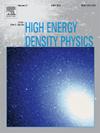Dynamic localized hot spot mix extraction from images in ICF experiments
IF 0.9
3区 物理与天体物理
Q3 PHYSICS, FLUIDS & PLASMAS
引用次数: 0
Abstract
In Inertial Confinement Fusion Experiments at the National Ignition Facility, time-resolved x-ray images of the central hot spot are captured to diagnose the compression, symmetry and relative amount of mixed material. In this work, we extract bright localized mix features from the images to (1) obtain a more accurate measurement of the hot spot size (compression), (2) match the feature to known capsule defects, and (3) estimate the internal hot spot flow velocity. A new extraction tool was developed that uses derivatives of the size of the hot spot vs contour level to automatically pick out the localized mix features. The size of the “clean” hot spot is larger than that measured with the traditional hot spot analysis routines by 10–30 %. Additionally, since the images are time-resolved, the velocities of the localized mix features can be measured and give an indication of internal flows of the hot spot.
在 ICF 实验中从图像中动态提取局部混合热点
在国家点火装置的惯性约束聚变实验中,对中心热点的时间分辨 X 射线图像进行捕捉,以诊断混合材料的压缩性、对称性和相对数量。在这项工作中,我们从图像中提取明亮的局部混合特征,以便:(1)更准确地测量热点大小(压缩);(2)将特征与已知的胶囊缺陷相匹配;以及(3)估计内部热点的流动速度。我们开发了一种新的提取工具,利用热点大小与轮廓水平的导数来自动提取局部混合特征。干净 "热点的尺寸比传统热点分析程序测得的尺寸大 10-30%。此外,由于图像是时间分辨的,因此可以测量局部混合特征的速度,从而显示热点的内部流动情况。
本文章由计算机程序翻译,如有差异,请以英文原文为准。
求助全文
约1分钟内获得全文
求助全文
来源期刊

High Energy Density Physics
PHYSICS, FLUIDS & PLASMAS-
CiteScore
4.20
自引率
6.20%
发文量
13
审稿时长
6-12 weeks
期刊介绍:
High Energy Density Physics is an international journal covering original experimental and related theoretical work studying the physics of matter and radiation under extreme conditions. ''High energy density'' is understood to be an energy density exceeding about 1011 J/m3. The editors and the publisher are committed to provide this fast-growing community with a dedicated high quality channel to distribute their original findings.
Papers suitable for publication in this journal cover topics in both the warm and hot dense matter regimes, such as laboratory studies relevant to non-LTE kinetics at extreme conditions, planetary interiors, astrophysical phenomena, inertial fusion and includes studies of, for example, material properties and both stable and unstable hydrodynamics. Developments in associated theoretical areas, for example the modelling of strongly coupled, partially degenerate and relativistic plasmas, are also covered.
 求助内容:
求助内容: 应助结果提醒方式:
应助结果提醒方式:


